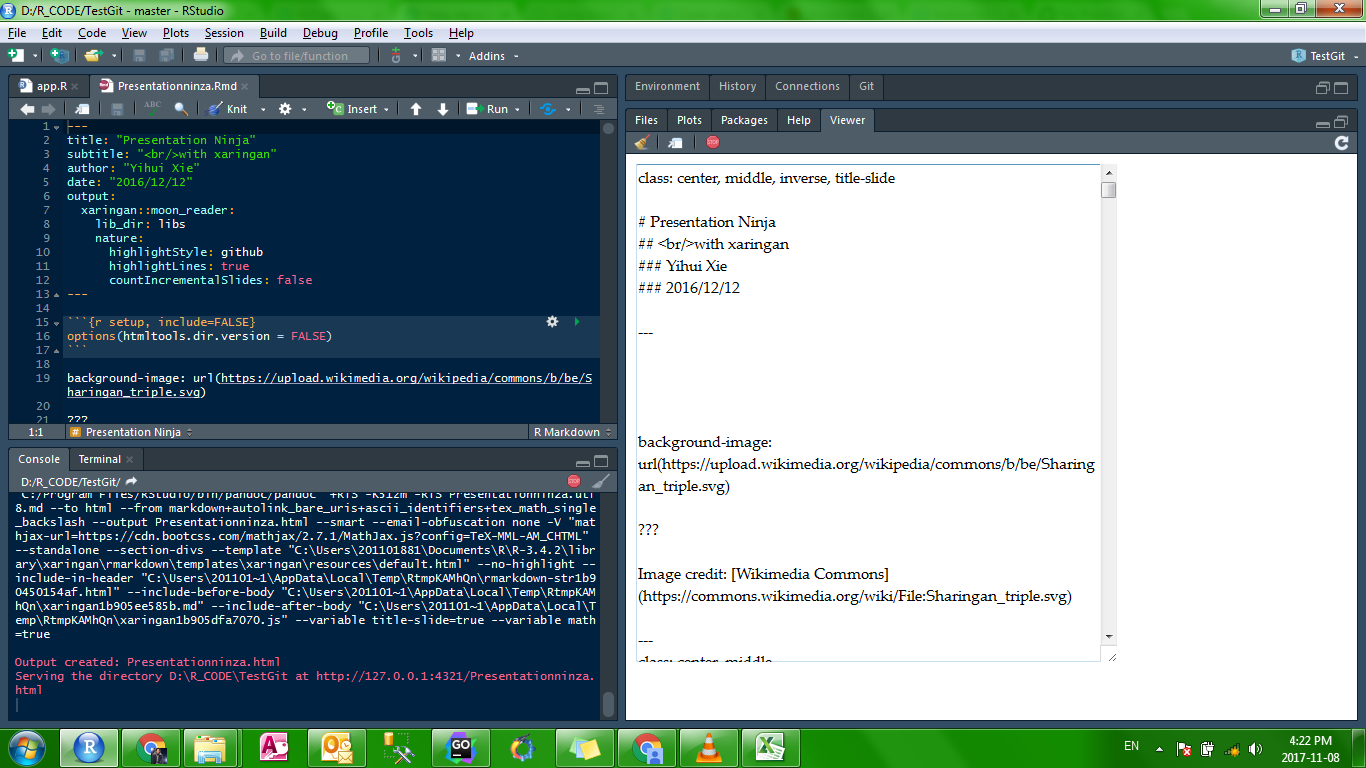
I added a logo in the center of the slide.Then delete all the existing boxes for footers.Insert the date and slide number from the Insert menu.

Add custom text boxes in the footer for date and page numbers.Next, I am selected Corbel for the body or content area.That means we can customize only these four layouts. RMarkdown and Pandoc currently support only these four layouts: Here you will see all the default layout options. We can resolve some of these issues by providing our custom PowerPoint template. Both the charts are taking the same smallish space.The slide titles are aligned in the center and the long title doesn’t fit neatly.It created the two-column layout as well.

It also has an external image from a URL.
Rmarkdown presentation code#
Code language: R ( r )Īfter hitting knit, you will see that the PowerPoint presentation has the line plot and the treemap we generated using ggplot. This is a tough market to break into, but you can carve a niche out.ĭon 't go head-to-head with the big companies. I have also added a caption by using fig.cap option. I have used include_graphics from knitr to add the image. The next slide is a chart from a website showing opportunities. Plot.title = element_text(face = "bold"), Labs(title = "Market Share of Streaming Services", Ggplot(market_share, aes(area = share, fill = company, label = paste(company, percent(share), sep = "\n"))) + # The market is packed with many streaming options
Slide 6: Side by side comparison of Netflix and Disney+. Slide 4: Survey of the market: market share. Slide 3: Survey of the market: share prices. Here’s how we will structure the presentation: Our client is a company trying to enter in this market. With these presentation design best practices, let’s dive into creating PowerPoint presentations with R and RMarkdown.įor this post, let’s say that we are studying the streaming services market. If you notice any of the consulting company’s presentations, you will see they have many charts, call-outs, and notes with references. Each supporting argument is further supported by more arguments and data. Then provide the supporting arguments with data and facts. You start with your main idea or recommendation. It provides a good structure for organizing your presentation content. She invented the Minto pyramid to help consultants make effective business presentations. Let’s talk about the Minto principle also called the Minto Pyramid.īarbara Minto was McKinsey consulting’s first female MBA professional. Use of body content to support your point mentioned in the title. Use the slide title to make your point or ask a question. Some of the main points from this book are: He explains why these business presentations work. Strategic Storytellingĭave McKinsey, the author of Strategic Storytelling, provides examples from top management consulting companies such as McKinsey and Accenture. 
Although these types of presentations are better for keynotes, we will try to apply some of these principles.

He also suggests using simple charts to make your point. We will see whether we can make that happen. He also recommends using the rule of thirds to place the point of focus in the intersection of lines dividing the slide into three equal sections horizontally and vertically. Garr Reynolds, the author of Presentation Zen, recommends the use of full-bleed background images with one sentence, a word, or statistic.
Using officedown/officer R libraries for further customizationīefore we jump into creating these presentations, I would like to share a quick overview of PowerPoint and presentation design best practices from two books: Presentation Zen and Strategic Storytelling. Syntax for authoring HTML, PDF, and MS Word documents.Watch step-by-step instructions on YouTube We will see three ways of creating PowerPoint presentations: However you need to provide a lower level of the heading for the slide title, e.g. This default can be overridden by specifying an explicit slide_level By default this is the highest header level in the hierarchy that is followed immediately by content, and not another header, somewhere in the document. The slide_level option defines the heading level that defines individual slides. I think the slide_level option might be what you are looking for:








 0 kommentar(er)
0 kommentar(er)
